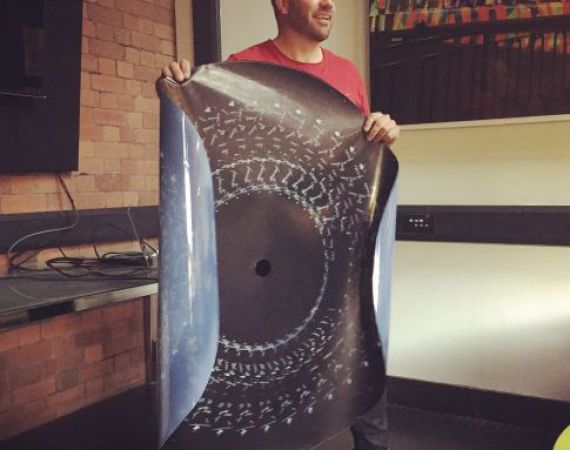Lunchtime talk write-up
Posted on Mon 16 Nov 2015
Discovering Sense of Place through a large scale hybrid zoetrope
Resident conservationist, film director and visual artist, Matt Bjerregaard, took the floor on Friday 23 October to reflect on and share his experiences of his recent creative endeavour. Matt was commissioned by Somerset Art Weeks to collaborate with two other artists, and using a combination of…

Matt Bjerregaard with his labour of love
Posted by
Resident conservationist, film director and visual artist, Matt Bjerregaard, took the floor on Friday 23 October to reflect on and share his experiences of his recent creative endeavour. Matt was commissioned by Somerset Art Weeks to collaborate with two other artists, and using a combination of contemporary and more traditional methods, create participatory light installations in the Brean Down fort in Weston-Super-Mare. Entitled Sense of Place, the site-specific exhibition intended to respond to stories of the people, landscape and buildings and communicate the rich history of the Fort. As part of his contribution, Matt created a mesmerising hand-cranked zoetrope that revived the writings of a British prisoner of war.
Here are 5 things I learned in Matt’s talk:
1. Working outside of your comfort zone can yield successful results.
Despite his expertise in digital, for this project Matt opted for more native uses of visual communication to complement the historical setting of the work. Zoetropes, or forms of which, date back as far as 100 BC, and were particularly popular in the pre-film era of the mid 19th Century. They are operated by a spinning mechanism and allow a series of images to be viewed in quick succession, as an optical illusion, through a viewfinder. Matt saw the potential to work in more mechanical means, permitting him to experiment in manual creation - which, for this work, he favoured over a 3D-printed route. In terms of content, Matt had originally planned to landscape as a basis for inspiration, due to his background as a conservation scientist, until he came across an old letter that revolutionised his thinking...
2. Inspiration can be bought on eBay.
In researching the area and the era, Matt discovered a letter for sale on eBay - in the bizarre location of Florida, USA. Dated 21 November 1943, the authentic letter had been written by a British prisoner of war contacting his mother. There were marks on the letter where Germans had censored it. The prisoner never made it home. Matt started a selection process, isolating key words such as 'freedom' and 'abandoned', that would emphasise the raw emotion communicated by the son to his mother, and skilfully applied these to the surface of his zoetrope, so that as it was cranked at a certain speed, the script would appear to write itself in real-time, akin to the calligraphy of the handwritten letter.
3. You can create installation-ready artworks with things found around your home.
In the build of the zoetrope, Matt utilised a swivel chair, exercise bands and a drill as moving parts. To create the illusion of frames being relayed one-after-the-other, Matt incorporated a strobe light. The exhibition drew 3000 visitors - so popular the strobe managed to break!
4. Against popular belief, ‘Danny Boy’ is not an Irish ballad.
It was written by Frederic Weatherly of Portishead – just outside of Weston-Super-Mare! Matt had grand plans to sync a 78 turntable in the centre of the zoetrope and play the iconic song, but couldn't get an original press. As a heartrending alternative, Matt managed to find a local singer to do a live performance at the launch of the exhibition.
5. You can create effects similar to a zoetrope by using a bicycle wheel.
There is such a thing as a 'cyclotrope', assembling 18 frames around the circumference of a wheel (in between spokes) and then spinning the wheel over a mug or cup.
Read more about Matt's zoetrope in his own blog post.
